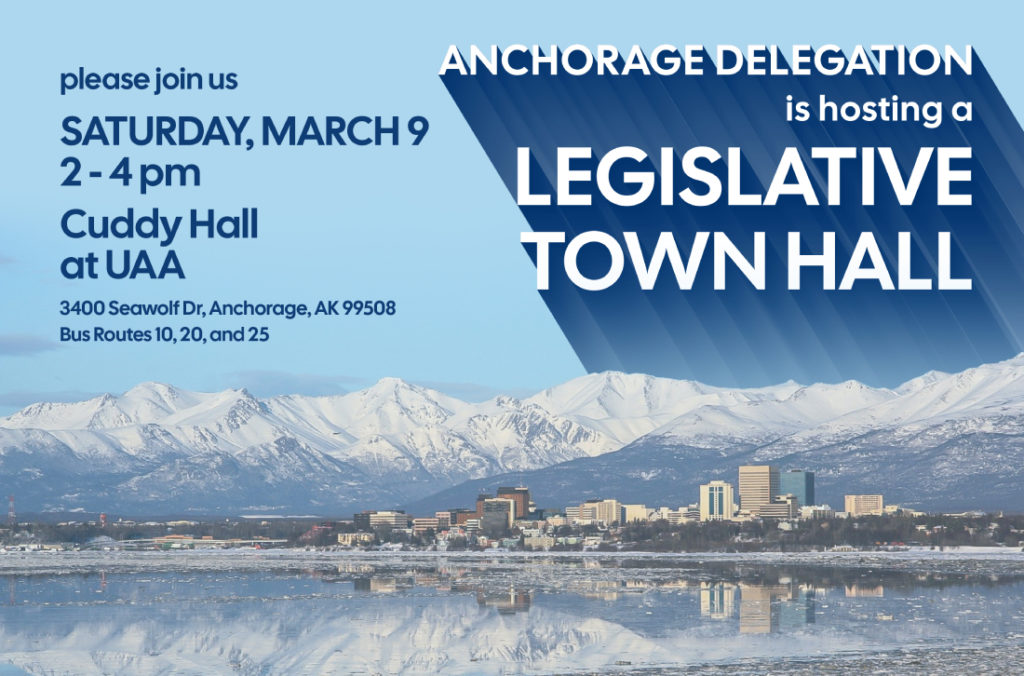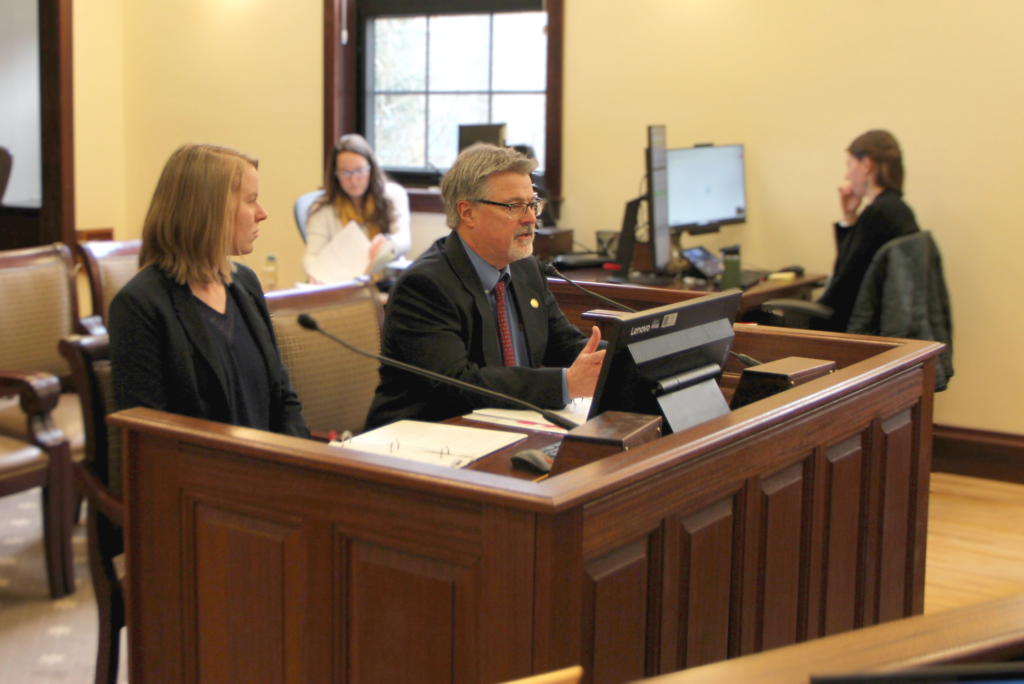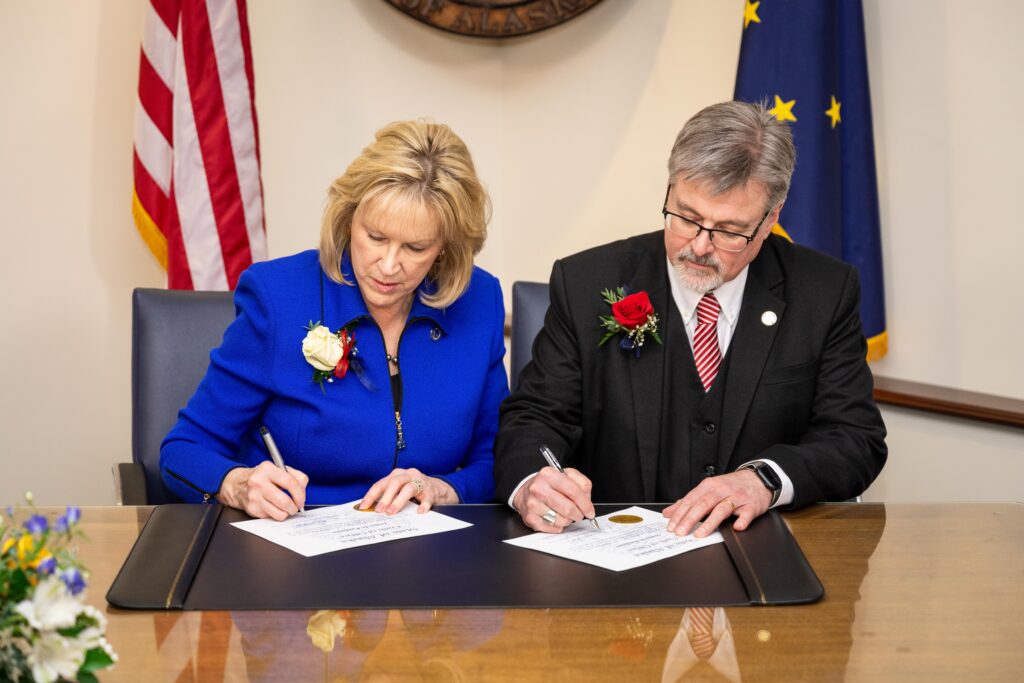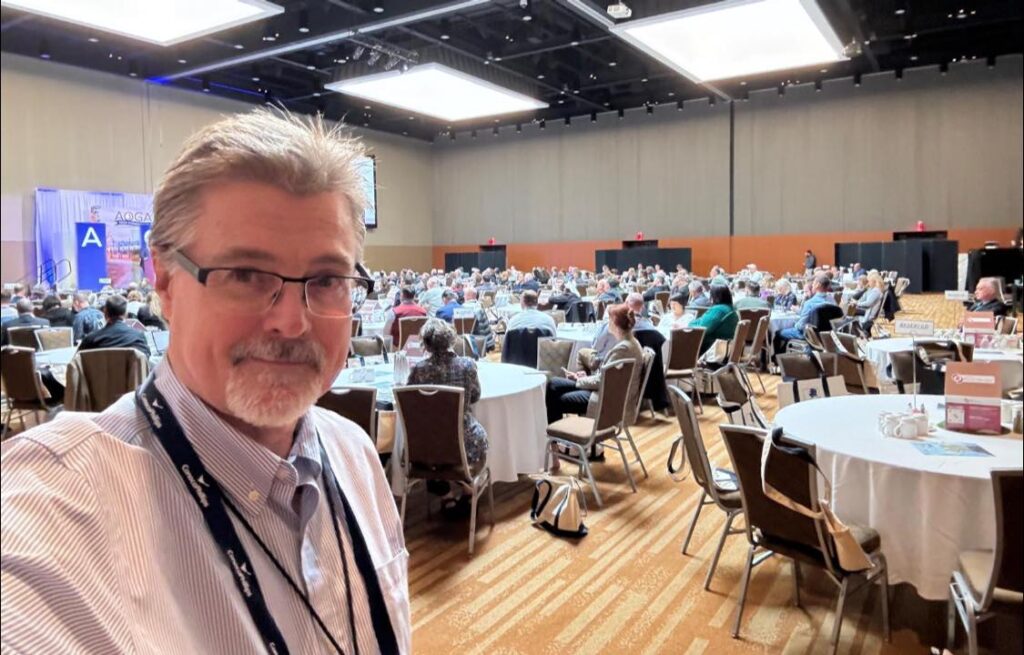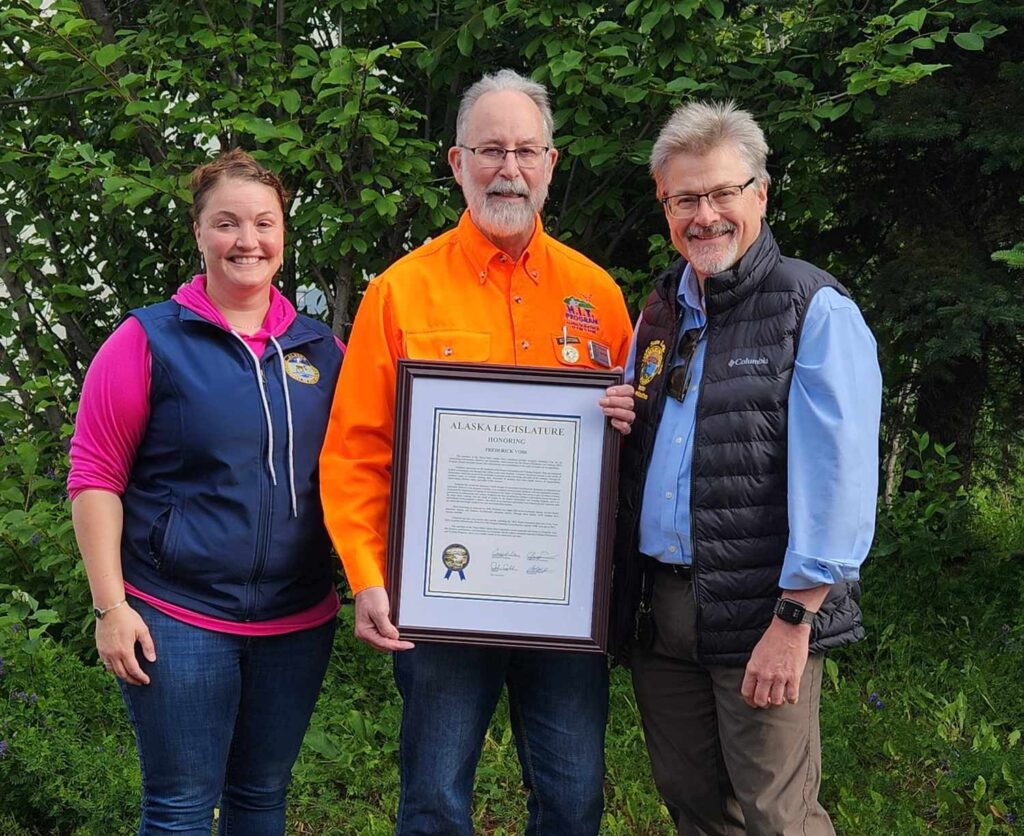Education, energy, the STIP, and tightening budgets are the big issues in the legislature right now. As always, there is much more below, but I’ll try to give a quick summary!
As I discussed in previous newsletters, SB 140 is the bill to watch as it has become the education vehicle for an increase to the Base Student Allocation, internet for rural schools, and other elements of education reform as I discuss in detail below. It passed the House and Senate with broad bipartisan support, but the Governor has expressed reservations that it did not include enough of his priorities. The risk is that he could veto it if his concerns are not somehow addressed. A great deal of work is now being done behind the scenes and in our education committee to try and find a compromise.
On the energy front, there are two broad topics, one is how to ensure we have the gas supply we need to heat and power our utilities and the other is nailing down what is needed to improve our our transmission and distribution of electrical power. There are many proposals currently being considered on how to address the short term supply, even as longer term (more expensive) proposals are on the mid-term and short-term horizon.
Meanwhile, our office is pulling hard to keep our many bills in motion, sometimes it feels like juggling (and trying to solve) Rubik’s cubes. See below for the status of our bills and resolutions.
I also visited Service High School for a follow up meeting with the faculty and spent time with the students and faculty of North Star. Two very different educational environments, and a good cross-section of the challenges that we face in education.
We have a big town hall event coming up this Saturday at Cuddy Hall, on the UAA campus, see below for details and please try to attend if you can!
Thank you for subscribing and taking the time to review our updates. Please remember that you can call me anytime at 907-465-4949 and keep up with day-to-day things on my Facebook page.
My Bill Passes the Senate!
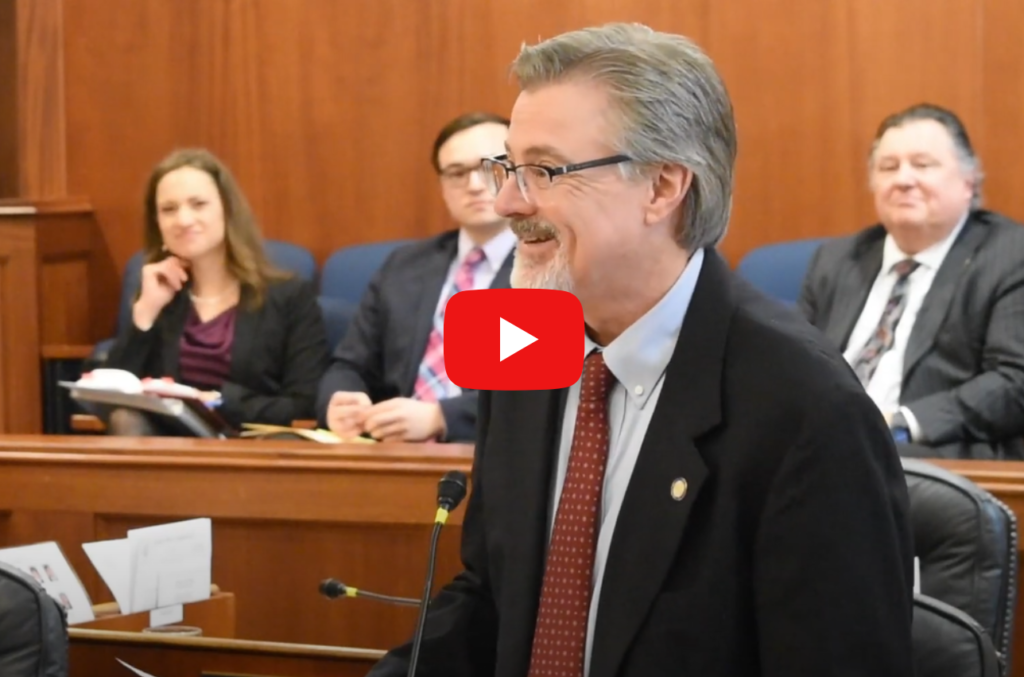
Helping Alaskans Get Back to Work | SB 147
Alaska is a difficult state to do work in and workers get injured. Sadly, these injuries can leave them unable to stay in the same line of work. Senate Bill 147 will help workers in that situation get retrained and back to work again. Alaska has a workers’ compensation law that is intended to help these injured workers get properly compensated and, if possible, retrained in a new profession. Unfortunately, the law has become woefully outdated. My bill would make important updates to it, including increasing reimbursement rates for the cost of retraining and other provisions that will help those who keep our state running!
Education
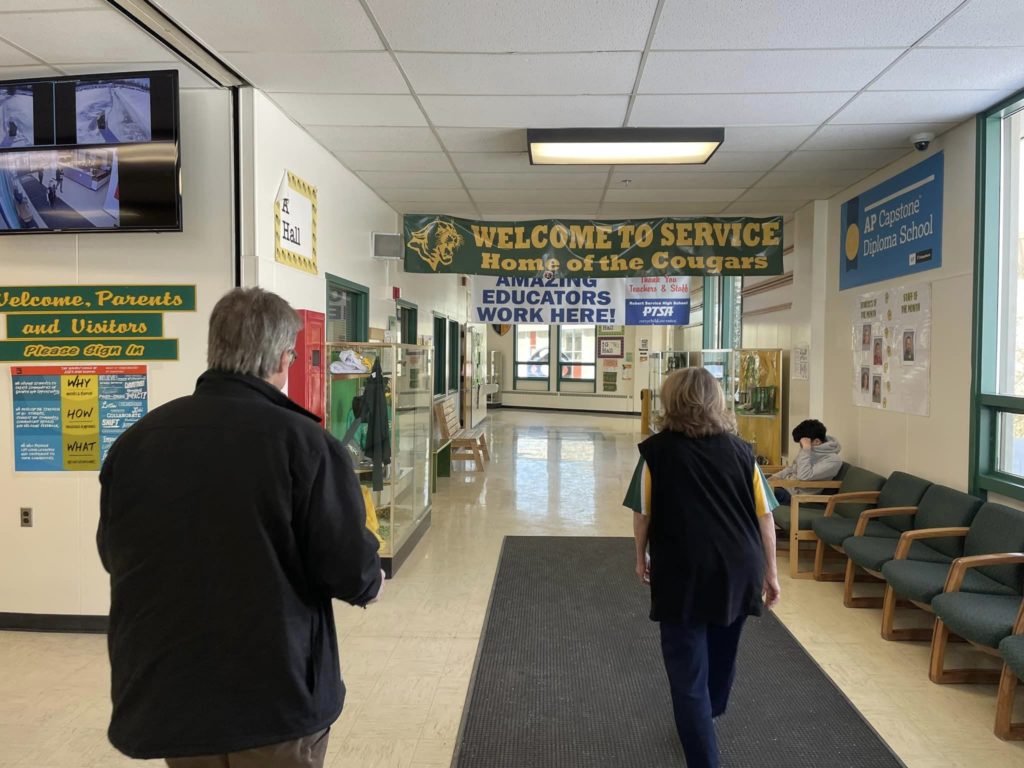
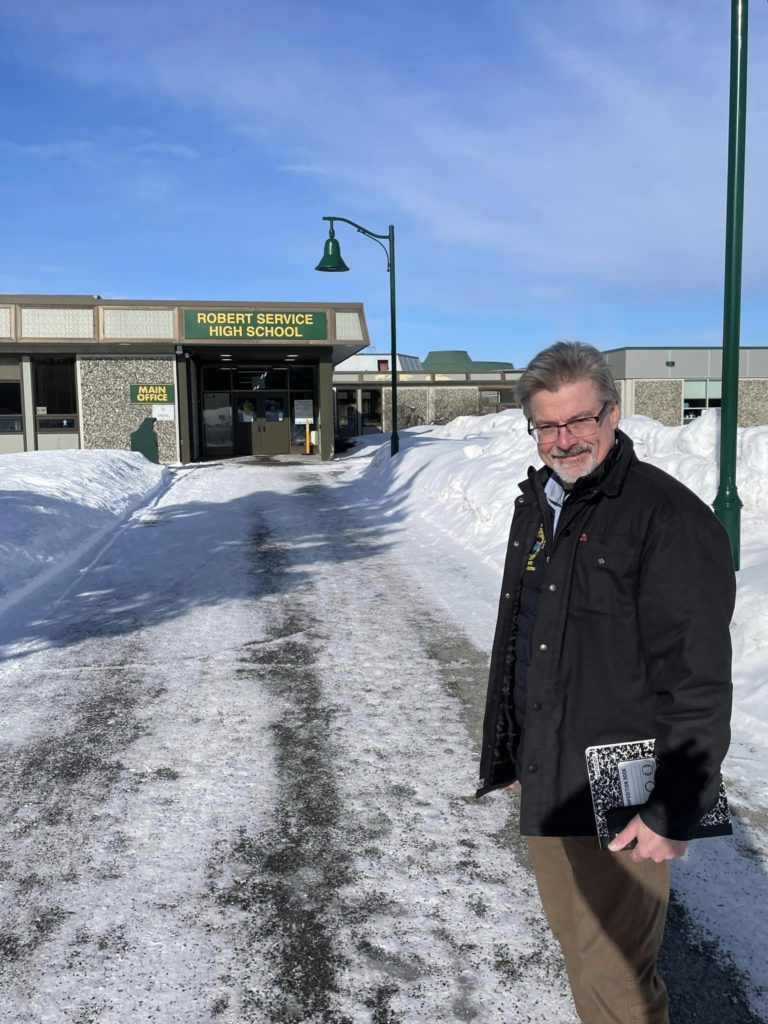
It’s about time for an education policy update! I wrote an extended piece about education, specifically the BSA, in a previous newsletter. You can read that here >>
Since I wrote the previous education section some big things have happened.
SB 140 passed the House with broad support (38 yes votes and 2 no votes). Since changes were made to the bill in the House, the bill was required to be returned to the Senate for a “concurrence” vote in which the Senate would either agree with the changes made in the house or oppose the changes in favor of a previous version (a more narrow version of SB 140 had already passed the Senate). The Senate voted to concur with the House changes on a vote of 18 yes votes and 1 no vote. Here is my statement that I put out on my Facebook page:
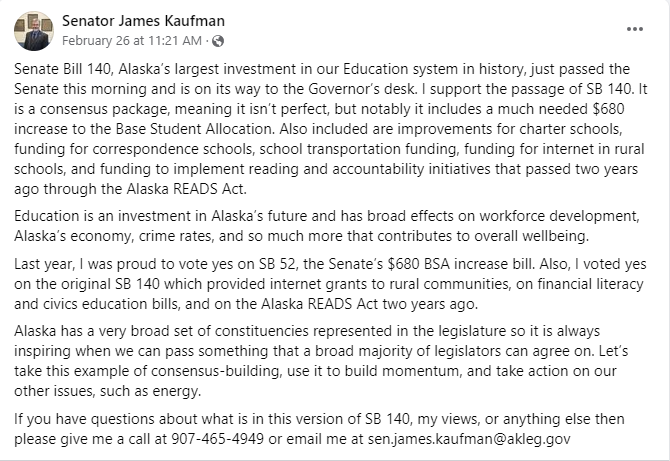
Now that SB 140 has passed the full legislature, it is on the Governor’s desk for signature or veto. Article 2, Section 17 of the Alaska Constitution states that a bill may also become law without signature if the governor “neither signs nor vetoes it within fifteen days” which would put the deadline at next Thursday, 3/14/24. The day after SB 140 passed and was transmitted to the governor he held a press conference to discuss education policy and SB 140 specifically. That press conference is about an hour and is on Facebook here >>
In the press conference, the governor indicated that he was inclined to veto SB 140 if further teacher incentives, charter school provisions, and possibly more weren’t included in another bill before the deadline. It is my understanding that leadership from the Senate and the House is in discussions with the Governor’s office in an attempt to come to a resolution that will allow SB 140 to pass, whatever that may be.
Below are the provisions that are included in SB 140:
Increases the Base Student Allocation by $680 dollars.
Each school district shall provide a report to the legislature February 1st of 2025 and 2026 “… describing efforts made by the district to direct additional funds to the classroom…”
Increases eligibility for schools to receive a discounted internet services rate if their download speed is 100mbps rather than the current 15mbps.
Provides an evidence-based appeals process for charter schools who have their contract terminated by a local school board.
Adds a “Charter School Coordinator” position to the State Department of Education and Early Development that is meant to act as a navigator, resource coordinator, and subject matter expert to support charter schools.
Updates transportation per student allocations to keep up with increased fuel and asset costs.
Increases the foundation funding formula multiplier for state and district correspondence program funding from 0.9 to 1.0.
Adds $500 per K-3 student who is determined to have a reading deficiency based upon metrics passed by the Alaska READS Act two years ago.
As noted above and in my previous newsletter, I support SB 140. However, it is right on the very top-end of what we can afford. I would have rather we tightened up some of our asks and passed a bill similar to what the Senate passed last year, which was $50 million or so that could have then been put toward capital budgets. However, there is good money in the bill for reading support and not just public school support, but also support for improving charter school access, correspondence school support, and more. So this provides more wide-ranging, bi-partisan reforms. It’s just always tough dealing with the political and fiscal realities of limited state resources.
In the recent years and months, I’ve been traveling to many schools and have been listening intently to issues that teachers, principals, paraprofessionals, and others are directly engaged in. This section is starting to get a bit long so I’ll write more about this in the future, but a reoccurring concern is too much testing in elementary school and then mistargeted testing once we get to high-school that may be misrepresenting results of our schools. Also, we have some serious absenteeism issues. Lastly, there seems to be a general understanding (especially since ASD moved 6th grade into middle schools) that some elementary schools should be merged, which would create some cost savings.
Because of length, I had to trim some parts of this section short and maybe skim over some details. So if you have any questions or comments feel free to reach out via email or phone and I’ll try my best to reach out.
Phone: (907) 465-4949
Email: sen.james.kaufman@akleg.gov
Capital Projects for our District
Each year, our Senate office works with Representative Julie Coulombe (House District 11) and Representative Calvin Schrage (House District 12) to submit our district’s capital project requests. Both of our representatives in the House have been great to work with on these requests. Since the beginning, I’ve tried my best to be very active with the community councils in my district, which are a great resource for capital project input (as well as other general feedback).
Our main focus this year is a greatly needed project focused on school-children crossing safety to O’Malley elementary school. Other top priorities include street upgrades, area recreation projects, local behavioral health facility improvements, and disaster evacuation routes in the case of a fire.
Something I caution people about every year is that there is always a competition for funds between every state expenditure. From education to energy to public safety to clean water, emergency and fire response, court systems, and on and on. Therefore, none of the projects on this list are guaranteed to be funded. In fact, in the past it has been quite difficult to fund a project through the CAPSIS process.
I advise the community councils that I work with to also focus on the AMATS (local transportation planning group) process, the Municipality of Anchorage processes, and other local plans. Many of these projects are locally driven, so starting engagement at these levels is highly advised. I have more extensive lists of projects included in local plans available upon request (or they may be posted on my website senatorkaufman.com soon). For nonprofit groups I advise grassroots efforts, community engagement, and reaching out to resources such as forakergroup.org who provides great education and support.
Please don’t take any of those cautionary statements to mean that we don’t push as hard as possible for these capital projects. I also encourage you to send me letters of support for any projects included in the full list of submitted projects below.
The main community councils in District 11 are the Hillside and Huffman/O’Malley community councils. The main community council in District 12 is Abbott Loop community council. I encourage you to visit communitycouncils.org and get engaged.
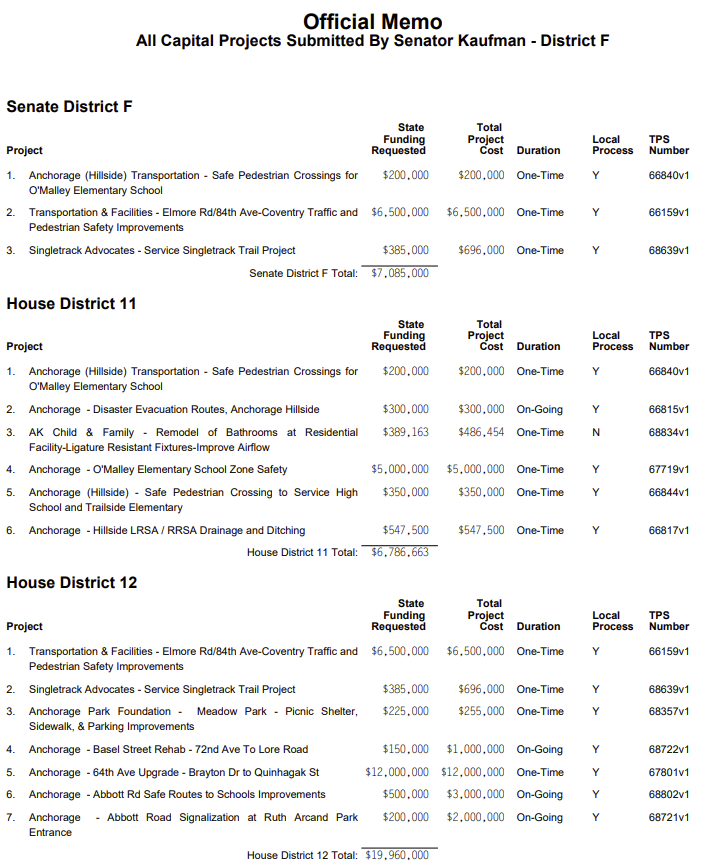
Visiting Service High School
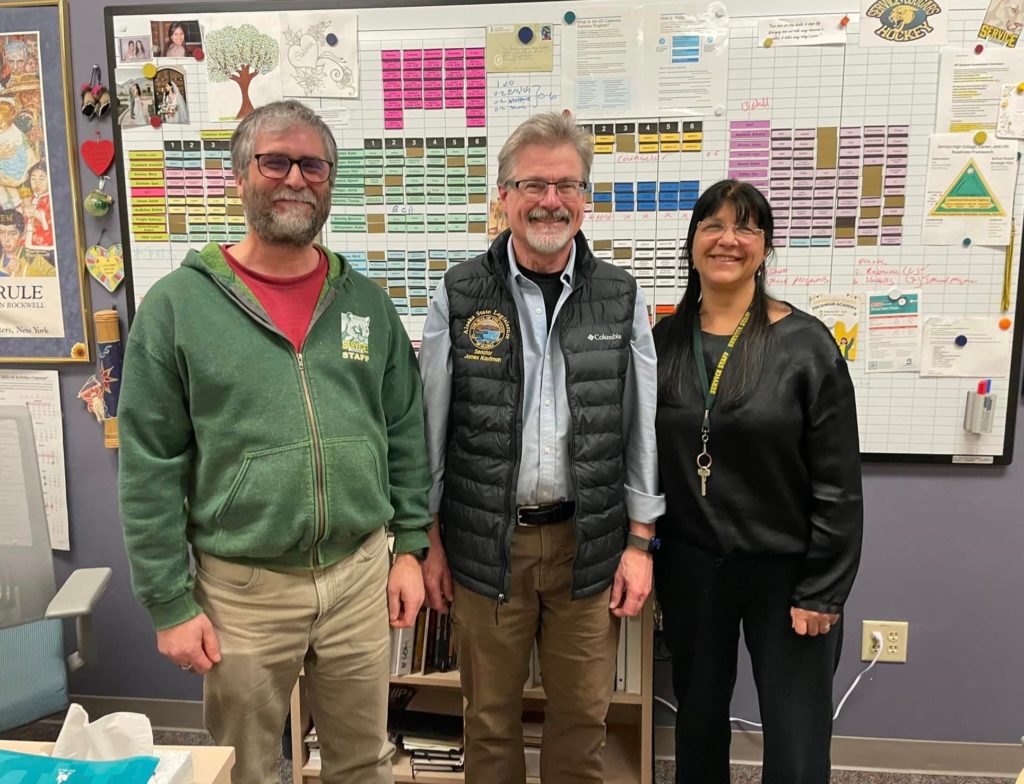
Later in the week, I had the chance to sit down with Service High School principal Imtiaz Azzam and Science Department Chair and teacher Daniel Maclean and talk about the big education issues as they see them. I am finding it extremely valuable and rewarding to spend time with our local educators and students.
We discussed challenges with attendance, testing, and curriculum, touched on some new programs they are piloting, and spoke about the education funding bill that passed both the House and the Senate earlier this week (and which is now awaiting the Governor’s signature).
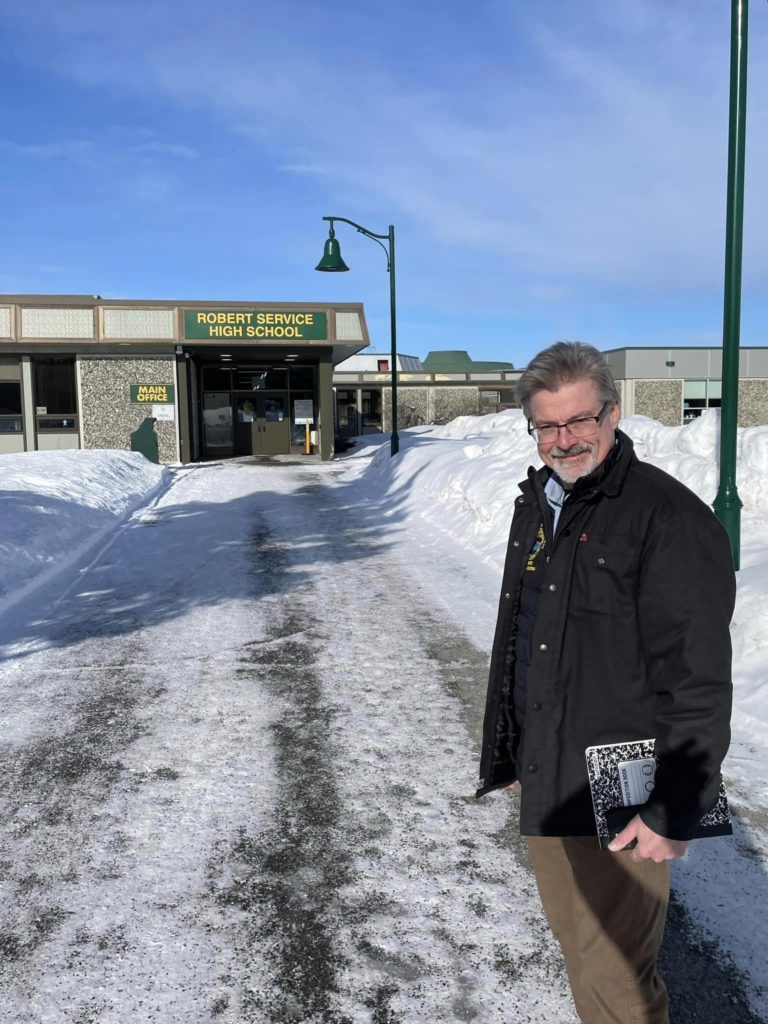
As mentioned above, I plan to write more about education policy that is not included in SB 140 in the near future.
My office will continue to work with educators and other stakeholders to ensure that we craft policy that helps deliver a quality education to all students. I already have more school visits scheduled for this month!
Service High Artists in the Capital
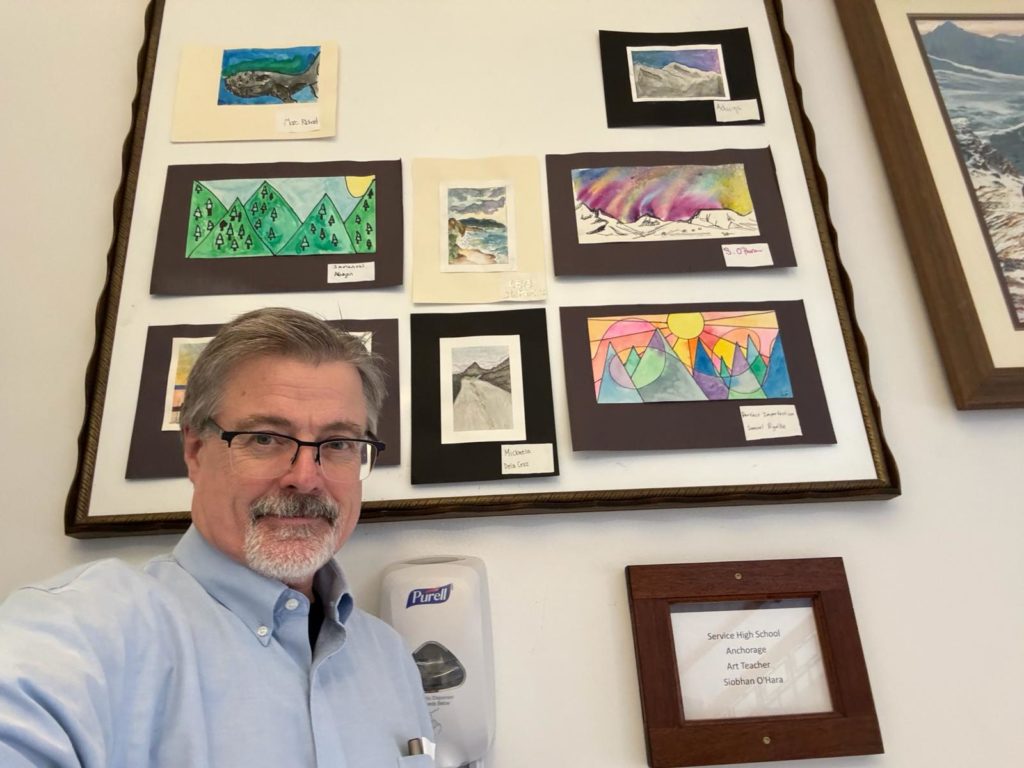
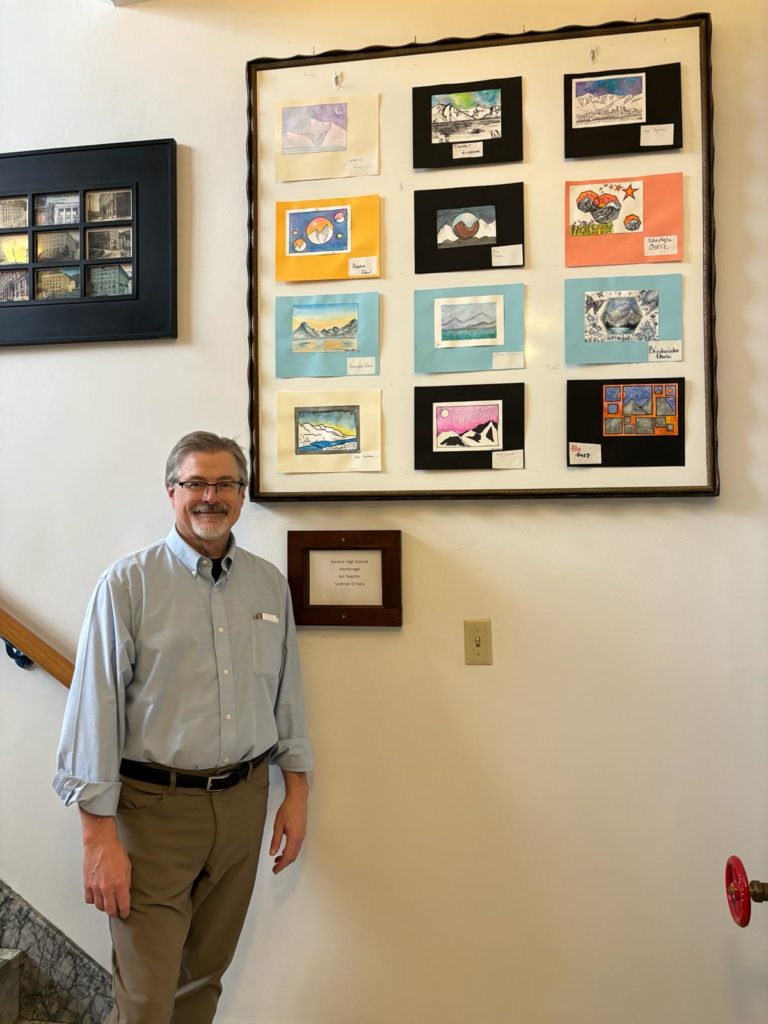
These talented students from Siobhan O’Hara’s art class are being featured right now in the halls of the Capital. It’s great to see a piece of home when I’m down in Juneau.
Update on Road Construction Projects for this Summer (a STIP update)
After Alaska’s Statewide Transportation Improvement Program (STIP) was initially rejected on 2/12 by the Federal Highway Administration (FHWA), AKDOT has been working overtime since to correct the issues. DOT and FHWA have been communicating throughout the process to ensure that DOT is on the right track with their corrections. In my last newsletter I discuss the initial STIP rejection (a few sections into the edition).
On Friday, March 1, DOT formally resubmitted the STIP, and from an initial look, it appears it incorporates the Tier 1 changes that are required. FHWA now has 30 days to approve the STIP to ensure that the summer construction season will move along as planned.
After a STIP is approved, DOT will need to resolve a number of other, smaller issues. From what we’ve been told, they will have the next several months to make those changes.
If you are interested in learning more, here are the letters I referenced above. They help shed more light on the specific issues DOT and FHWA are working through:
2/12 FHWA to DOT: Detailed rejection list with corrective actions
2/22 AKDOT to FHWA: Requesting review of their proposed corrective changes
2/23 FHWA to AKDOT: Responses to each of DOT’s proposed corrective changes (the appendix includes DOT’s letter with FHWA’s response after each proposal)
3/1 AKDOT to FHWA: AKDOT’s Formal Resubmitted STIP Package
For background: The STIP is the state’s four-year program for transportation system preservation and development. It includes interstate, state and some local highways, bridges, ferries and public transportation, but does not include airports or non-ferry-related ports and harbors.
As the chair of the Senate Transportation Committee, this topic is of extreme importance to me. This year and last year, we held hearings specifically focused on the planning process and STIP development (see topics and links below). Now that the STIP has been resubmitted, we plan to invite DOT before the Senate Transportation Committee soon to ask more questions about the lessons learned through this process and how they plan to ensure this does not happen again.
1/31/2023 Senate Transportation Committee, Federal Funding and Planning for the Future: https://www.akleg.gov/basis/Meeting/Detail?Meeting=STRA%202023-01-31%2013:30:00#tab4_4
2/14/2023 Senate Transportation Committee, Strategic Investment Decisions and Transportation Planning Data: https://www.akleg.gov/basis/Meeting/Detail?Meeting=STRA%202023-02-14%2013:30:00#tab4_4
8/22/2023 Joint Senate and House, Alaska’s Modern STIP: https://www.akleg.gov/basis/Meeting/Detail?Meeting=STRA%202023-08-22%2010:00:00
2/28/2024 Senate Finance Committee, STIP Update focused on what DOT was doing to prepare for resubmitting the STIP: https://www.akleg.gov/basis/Meeting/Detail?Meeting=SFIN%202024-02-28%2009:00:00#tab2_4e
As you can see, we followed the development process over the full year, but DOT did not let us know ahead of time that there were major issues. As soon as we can rest assured that Alaska’s construction season will move forward, we will look for ways to provide any systemic fixes that are needed so that this doesn’t happen again.
Alaskan Earthquakes Transform Building Codes
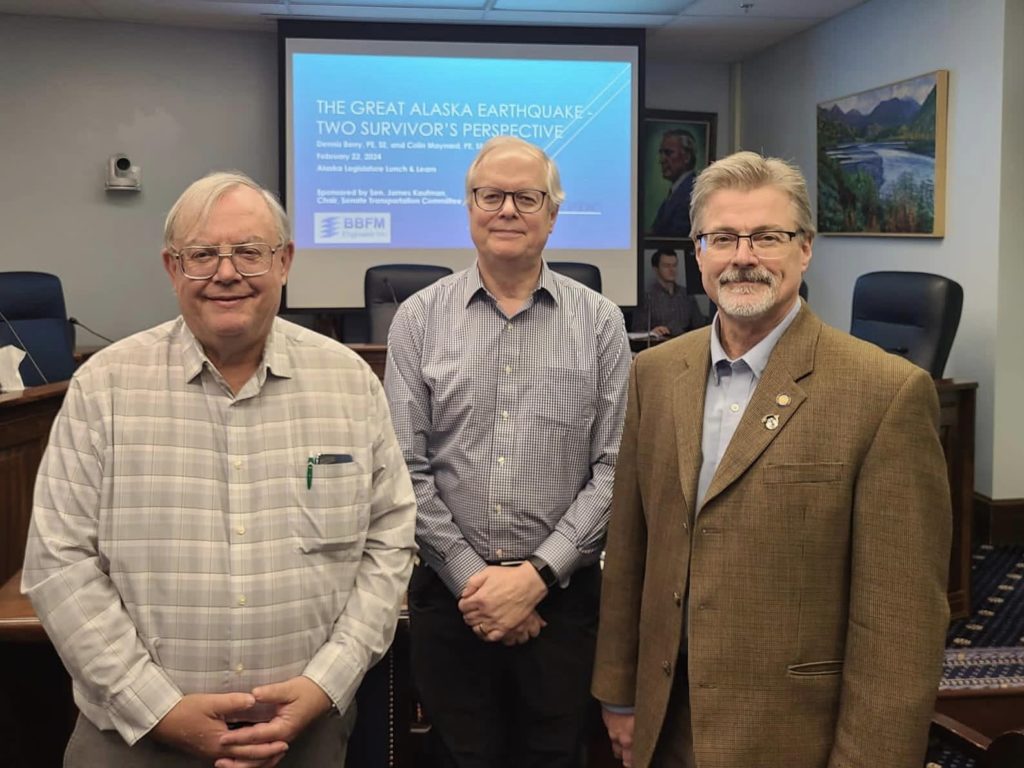
I hosted a Lunch and Learn (these are learning events that organizations can hold in the Capitol to inform legislators and staff here) last week about the 1964 and 2018 earthquakes from a structural engineer’s perspective. Both of these major earthquakes had (and are having) transformational affects on building codes across Alaska. I encourage you to give it a watch! >>
Thanks to Dennis L. Berry, PE, SE and Colin Maynard, PE, SE, F.NSPE with the Alaska Professional Design Council for a great presentation!
Anchorage Delegation Town Hall
As co-chair of the Anchorage Delegation, I continue to push for a unified approach to bipartisan initiatives that we as legislators from the Anchorage area can come together on. Recently, the Alaska Municipal League (AML) came to Juneau for their Winter Legislative Conference. This is organized every year in Juneau for communities around the state to hear from state agencies, learn about current legislation, address priority issues, and contribute to AML’s legislative strategy. Follow this link for more information and to view the presentations >>
Several members of the Anchorage Assembly were among those in attendance and I had the opportunity to meet with them while they were in town. We discussed the Anchorage Delegation and the Anchorage Assembly’s legislative priorities. View those priorities here >>
My Bills Heard Recently:
Securing Tourism and Economic Growth for Southcentral Alaska | SB 105
The Port of Seward is a tourism hub in Southcentral Alaska. Most cruise ship voyages begin or end in Seward, meaning visitors disembarking in Seward will travel on to the Kenai Penninsula or north through Anchorage, Denali, and even Fairbanks. The cruise ship dock in Seward was built in 1966 and has reached the end of its lifespan. SB 105 authorizes the Alaska Railroad to secure up to $135 million in revenue bonds to finance the replacement of the dock infrastructure. This project will ensure that the Port will continue to support small businesses and the broader tourism industry in Southcentral, the Interior, and beyond.
Increasing Efficiency of Affordable Housing | SB 205
The Alaska Housing Finance Corporation manages over 1600 units of affordable public housing around the state. Senate Bill 205 allows the AHFC to purchase a building in Anchorage that they can use for a maintenance and training hub. Ownership of this property will enable them to more efficiently plan, stage, and deploy personnel and equipment to service their properties.
GDP-Based Sustainable Spending | SJR 4 / SB 20
Senate Joint Resolution 4 / Senate Bill 20 is a functional state spending cap which constructively links our private sector performance (measured by GDP) and government spending. An effective limit like this one creates stability and predictability in our budgeting process – in economic boom years, extra revenues are pushed forward, preventing the need for drastic cuts in economic bust years. SB 20/SJR 4 was recently heard in the Senate Judiciary Committee.
The spending limit is set based on a certain percentage of Alaska’s private sector economic performance. Specifically, we use the Real GDP of Alaska minus government spending. As you can see below, this wouldn’t be a harsh cut or cap, but rather a smoothing mechanism that ebbs and flows with Alaska’s economy, preventing the boom and bust spending cycles Alaska goes through as oil prices and other events change.
My Continued Priority:
Improving Outcomes Through Budget Act Reforms | SB 21
Strategic planning, budgeting, execution, and reporting to help Alaska’s government improve performance and efficiency. I see this as the key to Alaska’s fiscal fitness and performance. The cohesive planning framework is laid out in the diagram pasted below. Three major plans for each department (strategic plans, performance plans, and financial plans) are guided by the Governor’s statewide priorities. This gets our state government looking ahead and planning strategically rather than getting by year-by-year and budgeting solely based on annual changes. This bill is currently in Senate Finance awaiting a hearing. For more information click here: https://senatorkaufman.com/executive-budget-act
ASD Gifted Mentorship Program
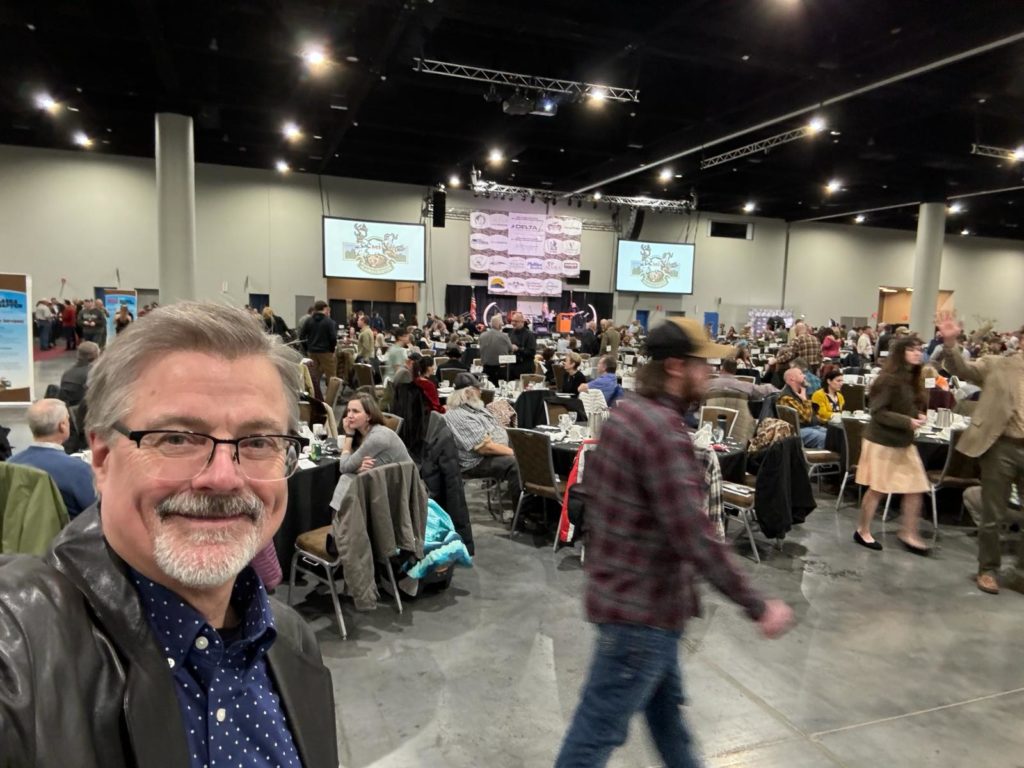
As always, Safari Club International’s Annual Banquet was a great event. Appreciate the work these folks do!
In case you missed it:
Anchorage Snow Removal Presentation:
The Department of Transportation came to my committee on February 1st and talked about snow removal and winter storm response. I’ve heard your frustrations about how difficult it is to get around (especially on the hillside) days after big snowfalls. I’ll continue to work with the Department on ways to improve service and response times.
Watch the whole hearing here >>
Watch the Anchorage-specific portion >>
Senator Sullivan’s Annual Address
Senator Dan Sullivan delivered his annual address to the Legislature on February 21st.
Congresswoman Peltola’s Annual Address
Congresswoman Mary Sattler Peltola delivered her annual address to the Legislature on February 26th.
Find your Community Council
Don’t know which Community Council area you live in? Find out here >>
📌 |
Hillside Home & Land Owners (HALO) MeetingCandidate Forum Hillside Residents will have the opportunity to meet candidates running in the upcoming Municipal elections. The Forum will be held at the Alaska Zoo’s Community Room. |
📌 |
Huffman/O’Malley Community Council MeetingThursday, March 21, begins 7:00PM |
📌 |
Abbott Loop Community Council MeetingThursday, March 28, 6:30-8:30PM |

